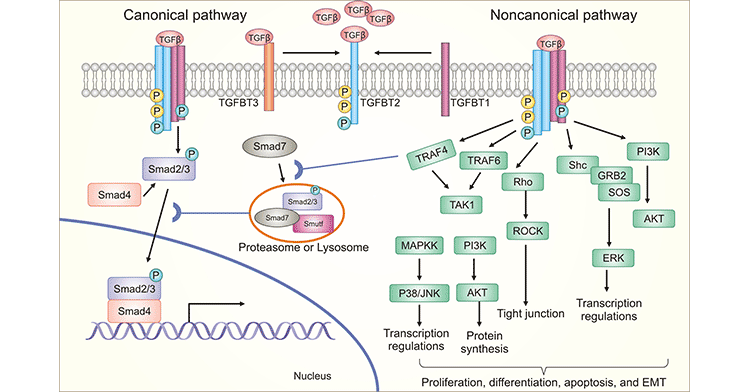TGF-beta Receptor
Transforming growth factor beta, also known as TGF-beta or TGFβ, is a kind of multifunctional cytokine with conservative structure. It functions as a regulator involved in cell proliferation, differentiation, and production of products in the extracellular matrix, and plays an important role in embryogenesis, hematopoietic regulation, immune regulation, and inflammatory responses. Similar to other cytokine, The action of TGFβ on cells is through the combination of specific receptor on the cell surface, thereby initiating corresponding signaling pathways. The specific receptor molecule on the cell surface is the TGFβ receptor. Research on TGFβ receptors and signaling pathways is also an important part of TGFβ-related research.
1. What Types of TGFβ Receptor?
So far, nearly 40 members of TGFβ family have been found in mammals, and they can be divided into 3 larger subfamilies according to their homology: TGFβ subtypes (β1, β2, β3), Activin and BMP, each family All include multiple members with the same structure but different functions [1]. The TGFβ family transmits signals by binding to receptors. According to their structural and functional properties, TGFβ receptor can be divided into three types, including type I receptors (TβRI), type II receptors (TβRII) and type III receptors (TβRIII) . The molecular weights of the three types of receptors are 53KDa, 70~80KDa and 280~330KDa, respectively.
Among them, TβRI and TβRII are single-pass transmembrane serine/threonine kinase receptors with intrinsic kinase activity that are required to mediate TGFβ signaling. Type I and type II receptors have similar structural characteristics in the extracellular region, and have a conserved sequence containing 5 cysteines near the N-terminal position. This conserved sequence isn’t found in other serine/threonine kinases. Therefore, it is believed that this is a structure involved in the binding of TGFβ and the receptor. Type I and II TGFβ receptors are both glycoproteins, and their affinity with TGF-β1 is 10-80 times greater than that with TGF-β2. TβRIII, also known as Endoglin or CD105, is a proteoglycan. Although it is also a transmembrane protein, its intracellular segment lacks kinase activity and does not directly participate in signal transduction. It mainly regulates the binding of TGFβ to signal receptors (Type I and II TGFβ receptors). It has similar affinity with TGF-β1, TGF-β2, TGF-β3, and TGF-β1 and TGF-β3 are its main ligands.
2. TGFβ Signaling
The integrity of TβRI and TβRII complex are required for TGFβ signaling. TβRIs bind weakly to ligands and need to bind to type II receptors during signal transduction. The ligand specificity of the receptor complex depends on the TβRII, while the TβRII increases the affinity of the complex. TβRIIs can be autophosphorylated. After binding to ligands, their protein kinase activity catalyzes the phosphorylation of serine and threonine residues in the GS region of TβRIs, and the phosphorylated TβRIs are then transphosphorylated into cells. A group of downstream signaling protein molecules called Smads.
Smads proteins are a class of molecules directly involved in TGFβ signal transduction and play an important role in the process of TGFβ signal transduction. Type I receptor-dependent Smad molecules are called receptor-regulated Smads (R-Smads), and this class of Smads plays a role in specific TGFβ signaling pathways, including Smad2, 3, 5, and 8. Once activated, R-Smad will bind to other Smad molecules, such as Smad4, which can bind to most R-Smads, also known as co-regulatory Smads (Co-Smads). In mammals, only Smad4 is found to regulate gene transcription. The combination of the two forms an R-Smad/Co-Smad complex, which is then translocated into the nucleus to regulate the transcription of target genes together with other regulatory factors in the nucleus. Another type of Smad is the inhibitory type (I-Smad), such as Smad-6, 7, by blocking the binding of R-Smad to the receptor or Co-Smad, it negatively regulates the Smad signaling pathway. TGFβ/Smads signaling pathway is the main pathway for TGFβ to exert its action. In addition, TGFβ can also activate MAPK signaling pathway and PI3K/Akt signaling pathway in a non-Smads signaling pathway (as shown in Figure 1) [2].
Figure 1. TGFβ signaling transduction
Regard reading (you may interested in):
Double-Edged Sword: TGF-β
Do You Really Know TGF-β Superfamily?
3. Popular Targets Related TGFβ
CUSABIO has listed some popular targets related TGFβ, involving TGFβ and its receptor family. Click on the corresponding target to view all the reagents related to the target.
References:
[1] SHI Y. Mechanisms of TCF-beta signaling from cell membrane to the nucleus [J]. Cell, 2003, 113(6): 685-700.
[2] Vander Ark, A., Cao, J., & Li, X.. TGF-β receptors: In and beyond TGF-β signaling [J]. Cellular Signalling. 2018, 52, 112–120.


